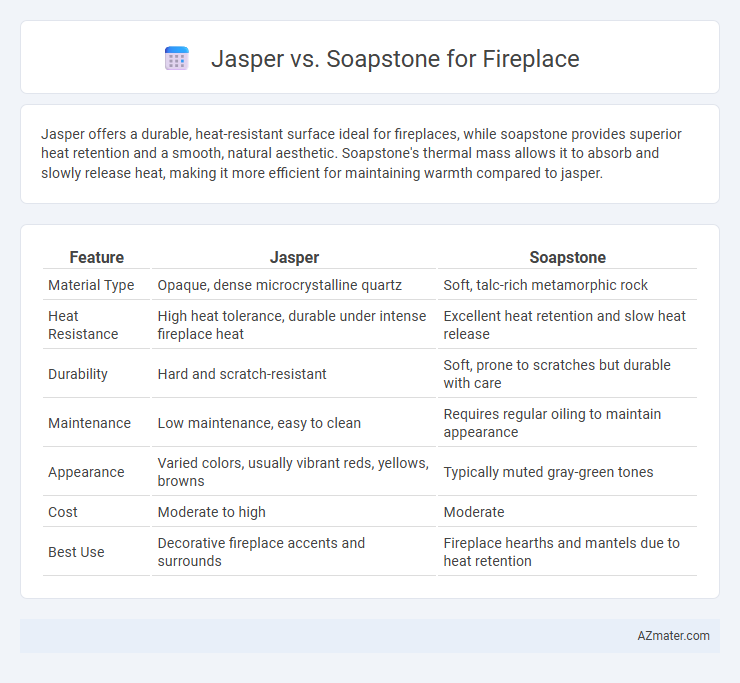Jasper offers a durable, heat-resistant surface ideal for fireplaces, while soapstone provides superior heat retention and a smooth, natural aesthetic. Soapstone's thermal mass allows it to absorb and slowly release heat, making it more efficient for maintaining warmth compared to jasper.
Table of Comparison
| Feature | Jasper | Soapstone |
|---|---|---|
| Material Type | Opaque, dense microcrystalline quartz | Soft, talc-rich metamorphic rock |
| Heat Resistance | High heat tolerance, durable under intense fireplace heat | Excellent heat retention and slow heat release |
| Durability | Hard and scratch-resistant | Soft, prone to scratches but durable with care |
| Maintenance | Low maintenance, easy to clean | Requires regular oiling to maintain appearance |
| Appearance | Varied colors, usually vibrant reds, yellows, browns | Typically muted gray-green tones |
| Cost | Moderate to high | Moderate |
| Best Use | Decorative fireplace accents and surrounds | Fireplace hearths and mantels due to heat retention |
Introduction: Jasper vs Soapstone Fireplaces
Jasper and soapstone are two popular materials used for fireplace surrounds, each offering distinct aesthetic and functional benefits. Jasper is a durable, gemstone-like stone known for its vibrant colors and unique patterns that add a striking visual appeal. Soapstone is prized for its excellent heat retention, smooth texture, and natural resistance to fire and corrosion, making it ideal for efficient, long-lasting fireplace designs.
Overview of Jasper and Soapstone Materials
Jasper is a durable, visually striking natural stone composed mainly of microgranular quartz and chalcedony, known for its rich colors and unique patterns, making it an attractive option for fireplace surrounds. Soapstone, a metamorphic rock primarily composed of talc, offers exceptional heat retention and resistance to soot and staining, providing both functional and aesthetic benefits in fireplace applications. Both materials are heat-resistant but differ in appearance and texture, with jasper showcasing vibrant, polished finishes and soapstone featuring a smooth, matte surface that darkens with age.
Heat Retention: Jasper Compared to Soapstone
Jasper exhibits moderate heat retention, allowing it to absorb and radiate warmth efficiently but cooling faster than soapstone. Soapstone outperforms jasper in heat retention due to its dense composition and higher thermal mass, making it ideal for maintaining steady heat over extended periods. Choosing jasper may suit shorter heat bursts, while soapstone ensures prolonged warmth for fireplace applications.
Durability and Longevity
Jasper is an exceptionally durable material for fireplaces, known for its high resistance to heat and wear, making it suitable for long-term use without significant degradation. Soapstone also offers excellent heat retention and durability, but it is softer and more prone to scratching and nicking over time compared to Jasper. For longevity and heavy use in a fireplace setting, Jasper provides superior structural integrity and maintains its aesthetic appeal longer than soapstone.
Aesthetic Differences and Color Variations
Jasper offers rich, earthy tones with vibrant red, green, and brown speckles that create a warm, rustic aesthetic for fireplaces. Soapstone features a smooth, matte finish with consistent gray and green hues, imparting a sleek, contemporary look that develops a natural patina over time. The choice between Jasper's dynamic color patterns and Soapstone's subtle uniformity defines the fireplace's visual impact and design style.
Maintenance and Cleaning Requirements
Jasper requires minimal maintenance due to its dense, non-porous surface, making it resistant to staining and easy to clean with mild soap and water. Soapstone, while naturally resistant to heat and staining, benefits from regular oiling to maintain its rich appearance and prevent discoloration over time. Both materials withstand fireplace environments well, but Jasper offers a slightly lower upkeep routine compared to Soapstone's periodic conditioning needs.
Cost Analysis: Jasper vs Soapstone
Jasper fireplaces typically cost less than soapstone models, with prices ranging from $1,500 to $3,000 compared to soapstone's $2,000 to $4,500, reflecting differences in material sourcing and durability. Soapstone's higher upfront cost is offset by its superior heat retention and resistance to cracking, potentially reducing long-term maintenance expenses. Homeowners prioritizing budget-friendly options may favor jasper, while those seeking longevity and efficiency often invest in soapstone despite the higher initial price.
Environmental Impact and Sourcing
Jasper stone is often sourced through quarrying methods that can lead to habitat disruption and increased carbon emissions, making its environmental impact more significant compared to soapstone. Soapstone, known for its durability and heat retention, is typically extracted from more sustainable deposits with minimal ecological disturbance, resulting in a lower carbon footprint. Both materials require careful consideration of quarrying practices and transportation emissions to ensure a more environmentally responsible choice for a fireplace.
Installation Considerations
Jasper and soapstone fireplaces differ significantly in installation considerations due to their material properties and weight. Jasper, being a dense and heavy natural stone, requires a reinforced hearth and professional handling during installation to ensure structural safety and stability. Soapstone, lighter and more heat-retentive, offers easier installation with less structural modification, making it a preferred choice for homeowners seeking efficient heat distribution and simpler setup.
Which is Better for Your Fireplace: Jasper or Soapstone?
Soapstone is better for fireplaces due to its superior heat retention, durability, and resistance to cracking under high temperatures, making it ideal for long-lasting warmth and safety. Jasper, while visually striking with its vibrant colors, is less heat-resistant and more prone to thermal shock, which can cause damage when exposed to intense heat fluctuations. Prioritizing fireplace efficiency and longevity, soapstone remains the optimal choice for both functional and aesthetic needs.

Infographic: Jasper vs Soapstone for Fireplace
 azmater.com
azmater.com